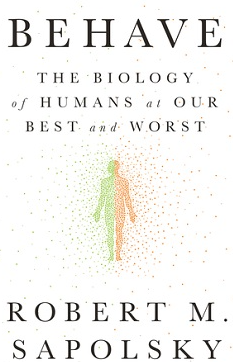Robert Sapolsky’s “Behave: The Biology of Humans at Our Best and Worst” isn’t your typical self-help book. Clocking in at over 800 pages, it’s a monumental exploration of the biological underpinnings of human behavior. For those curious about the very essence of why we do what we do, “Behave” offers a captivating, albeit challenging, journey.
This review will delve into the book’s strengths and weaknesses, highlighting its unique structure, engaging storytelling, and vast array of topics. We’ll also address potential drawbacks for readers unfamiliar with scientific concepts or short on reading time.
A Journey Through Time: Unveiling the Layers of Behavior
One of “Behave’s” most intriguing aspects is its structure. Instead of a linear narrative, Sapolsky takes a “time-traveling” approach. He starts by examining the immediate neurological processes happening in the brain moments before a specific behavior occurs. Then, he peels back the layers, exploring how genetics, childhood experiences, and even our evolutionary history influence those split-second decisions. This approach dismantles simplistic notions of good and bad, revealing a complex tapestry of forces driving our actions.
For example, imagine a situation where someone lashes out in anger. “Behave” wouldn’t simply label the person as “aggressive.” Instead, it would delve into the neurological processes in the amygdala, a part of the brain associated with emotions like fear and anger, that triggered the outburst. It might then explore how childhood experiences of abuse or genetic predispositions for stress sensitivity, which can heighten activity in the amygdala, may have played a role. Finally, the book might examine how our evolutionary history, where aggression could have been a survival strategy in competition for resources, still influences our behavior today.
This method of dissecting behavior from the immediate to the historical provides a rich understanding of human complexity. It encourages readers to move beyond judgments and consider the intricate interplay of factors that shape our actions.
Captivating Storytelling: Breathing Life into Science
A book of this size could easily become a dry, academic treatise. However, Sapolsky’s strength lies in his masterful storytelling. He weaves in fascinating case studies that bring scientific concepts to life. For instance, he discusses the case of Phineas Gage, a 19th-century railroad worker who survived a horrific accident that damaged his prefrontal cortex – the part of the brain responsible for impulse control and planning. Gage’s personality underwent a dramatic shift, showcasing the crucial role of the prefrontal cortex in shaping our behavior. Behave: The Biology of Humans
We also encounter Sapolsky’s observations of baboons in the African savanna. By studying their social hierarchies and aggressive behavior, he sheds light on the evolutionary roots of these behaviors in humans. These stories are not just educational; they are genuinely engaging. Sapolsky’s witty and self-deprecating humor adds another layer, keeping the tone light even when tackling heavy subjects. His ability to explain complex scientific ideas in an accessible way makes “Behave” a surprisingly enjoyable read, even for those without a background in neuroscience or biology.
A World of Topics: Exploring the Biology of Our Lives
The breadth of topics covered in “Behave” is truly impressive. We delve into the development of the prefrontal cortex, as discussed with the case of Phineas Gage, to understand teenage angst and violent aggression. The book tackles the contentious debate of nature versus nurture, demonstrating how genes interact with the environment to shape our behavior. For example, studies on twins raised apart can help untangle the relative influence of genes and environment on personality traits like intelligence.
We delve into the fascinating world of hormones, particularly stress hormones like cortisol. Sapolsky explores their profound impact on everything from aggression to depression. He discusses how chronic stress can lead to elevated cortisol levels, which can impair memory and decision-making, potentially contributing to mental health issues.
One particularly interesting section explores the biological roots of violence. Sapolsky dissects the evolutionary advantages of aggression, such as securing resources or defending territory, while acknowledging the devastating consequences of unchecked conflict. He explores the role of social hierarchies and competition in shaping human behavior, raising questions about our capacity for both cooperation and cruelty. “Behave” doesn’t shy away from the darker aspects of human nature, offering a scientific perspective on violence that can inform efforts to promote peace and understanding.
Behave: The Biology of Humans – The book also explores the biological basis of mental illness, showcasing how malfunctions in brain chemistry can lead to devastating consequences. For instance, it discusses how imbalances in neurotransmitters like dopamine and serotonin can contribute to symptoms of depression and schizophrenia. Sapolsky examines the biological basis of prejudice and xenophobia, offering insights into the “us vs. them” mentality that can fuel conflict.
